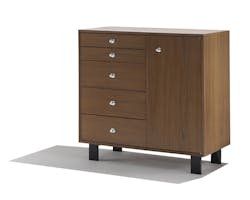Throughout its 94-year history, the Builders Hardware Manufacturers Association (BHMA) has been considered the go-to resource for commercial hardware standards. But there is a residential component as well which will be expanding in 2014 as BHMA prepares to release its first exclusively -residential standards.
It’s not a stretch for the organization, because certain existing ANSI/BHMA standards have both commercial and residential applications.
One major example of this is the standards involving cabinet hardware. Used and abused over many years, cabinet hardware may need to be some of the most durable builders hardware in a home or commercial building. To make sure it’s built to last, BHMA has developed stringent standards for all types of cabinet hardware.
Get Familiar with Cabinet Hardware
Take a close look at your cabinet hardware – it’s more than just pulls. All of the moving and connected parts of cabinets and drawers require several types of builders hardware.
BHMA breaks these down into the following categories:
- Pulls
- Hinges
- Knobs
- Catches
- Latches
- Shelf brackets/rests
- Shelf standards
- Drawer slides
While ANSI/BHMA standard 156.09, which covers cabinet hardware, delves into great detail about all of these product categories and more, it’s easy to acquire a basic knowledge by identifying each category and what defines it.
Pull. Surface or flush-mounted part used to operate a door or drawer. Pulls are probably the cabinet hardware consumers are most familiar with. Pulls can be back-mounted or surface mounted. Bail pulls drop down, are fastened from the back, and are either swinging or fixed. Flush pulls are mortised into doors and can be any desired shape.
Hinge. Hinges are actually divided into several sub-categories, including concealed, continuous, pivot, and olive knuckle hinges. The standard, a butt hinge, is attached to the edge of a cabinet door and the edge of cabinet face frame.
Knob. A projecting part, surface or back-mounted, used to operate a door or a drawer. Knobs can be back or surface- mounted and often feature a back plate.
Catch. A product with a holding capacity that keeps a cabinet door closed.
Latch. Much like a catch, it is a device used to hold a door, but it requires movement of an element before the door is released for opening.
Shelf bracket or rest. A member installed into a shelf standard, wall, or cabinet for supporting a shelf. While millions of varieties exist, most fall into the categories of adjustable, closed, or open.
Shelf standard. A slotted unit into which a bracket or rest is installed for supporting a shelf. These can be vertical or horizontal, and have ornamental options that be clean and modern or detailed and ornate.
Drawer slide. Element suspending a drawer and in which the drawer moves.
Cabinet Hardware: What to Look For
Consumers see and interact with cabinet hardware every day without giving it a thought. That is due in large part to the success and rigor of BHMA’s standards and certification program. BHMA standards test for durability, strength, and appearance or finish to assure that hardware has the best possible performance.
Durability ensures that products are built to last and won’t need to be repeatedly replaced, saving money and eliminating waste. Moving parts are repeatedly opening and closes and checked for the integrity of their performance over time.
Grade 1 cabinet hinges, for example, are required to withstand 100,000 cycles to be BHMA certified. Drawers are repeatedly opened and closed to show that they will stand the test of time and survive heavy use. Grade 1 door slides have to hold up during 50,000 cycles.
Strength is a critical factor in the performance of cabinet hardware. Products are tested for sagging and the weight of the load they can carry without degrading. Shelf rests and standards must meet requirements of “static load” testing, which requires shelves to withstand a 100 to 500 pound load.
Since most consumers are invested in the appearance of their cabinets, finish is important. BHMA tests for the durability of finish so products will remain as attractive as the day they were purchased. This is an even bigger factor in environments with salt or moisture in the air, such as humid Southern climates or seaside communities.
In the salt spray test, products are continuously subjected to a salty mist for anywhere from 8 to 48 hours, depending on the finish. Certified hardware must withstand this and still maintain its original aesthetic.
Bringing in Locks
For those concerned about security, ANSI/BHMA 156.11 covers cabinet locks. Cabinets are typically locked with various types of bolts or locks. Just like other cabinet hardware, cabinet locks are tested for durability and finish. However, the added dimension of security is included. Cabinet locks must stand up to seven aggressive tests; among them area 1,200 in-lbf. locked lever torque and two directions of impact.
For more information on ANSI/BHMA standards, testing, and in-depth details on cabinet hardware, visit the BHMA website at www.buildershardware.com.






